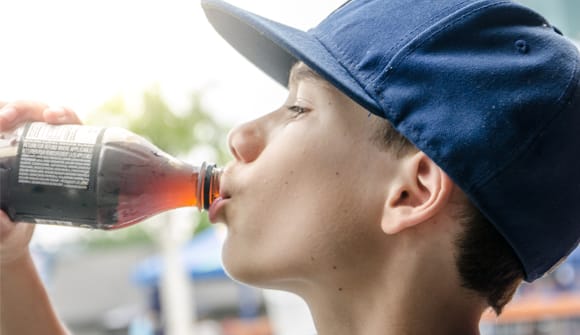Bad blend
Caffeine and kids don’t mix no matter how you brew it.
Article Author: Johnny Woodhouse
Article Date:

More than 70% of children consume caffeine on any given day, according to the Centers for Disease Control and Prevention, making them the fastest growing population of caffeine users.
And while its widely agreed that adults can safely consume up to 400 milligrams of caffeine daily, or about 4.2 cups of brewed coffee, the American Academy of Pediatrics (AAP) said there is no proven safe dose of caffeine for children 12 and under.
Caffeine is a stimulant that affects the central nervous system. A child who consumes too much of it may experience a variety of physical problems, from an upset stomach to an abnormal heart rhythm.
“Children are ultra-sensitive to caffeine,” said Christopher Wainwright, MD, a family physician with Baptist Primary Care. “That’s because kids are smaller than adults and it takes much less caffeine to cause adverse effects on their bodies and developing brains.”
Not a nutrient
It’s estimated that 85% of the U.S. population drinks at least one caffeinated beverage per day.
Caffeine is a compound found naturally in some plants and an additive in a variety of food and beverages. For example, an 8-ounce serving of coffee contains about 100 milligrams of caffeine. A similar serving of black tea contains about half that, according to the U.S. Food & Drug Administration.
A 12-ounce can of soda (regular or diet) has less caffeine than coffee or tea but may have excessive amounts of sugar. Many energy drinks, which also contain large amounts of sugar, can have up to 250 mg of caffeine per serving.
The AAP said energy drinks pose potential health risks because of the stimulants and other potentially harmful chemicals they contain and should never be consumed by children or adolescents. And because caffeine is not a nutrient, food manufacturers aren’t required to list it on product labels.
“Caffeinated beverages have no nutritional value for children,” said Dr. Wainwright. “But it’s the caffeine that keeps kids coming back to these drinks. That’s why It’s important for parents to check labels and ingredient lists to understand just how much caffeine is in each product.”
Hidden sources of caffeine
A variety of prepackaged foods and drinks can contain a surprising amount of caffeine. For example, a one-ounce square of unsweetened baking chocolate contains 23 milligrams of caffeine or nearly as much as an 8-ounce serving of carbonated cola. A cup of decaf coffee can contain up to 15 milligrams of caffeine.
Other products that may be hiding caffeine include:
- Coffee-flavored foods (ice creams and yogurts)
- Flavored sparkling water
- Snack foods (mints, gummy candy, chewing gum, energy bars)
- Lip balms and some skincare products
- Supplements (for weight loss or to boost energy)
What parents can do
Children and adolescents take their caffeine-use cues from their parents and other family members, and simply educating them about the detrimental effects of caffeine intake is not enough, according to a recent study.
Providing a healthy diet, adequate water intake, exercise, and sufficient sleep is the most effective method to keep children and teens active and alert.
Parents can also model good behavior by choosing non-caffeinated foods and drinks at mealtime and when dining outside the home with family, Dr. Wainwright said.
If you are concerned about your child’s caffeine use, talk with your child’s family physician about whether more intensive help or guidance is needed. Call 904.202.4YOU or click here to find the right physician for you.



